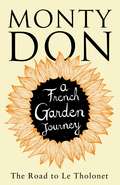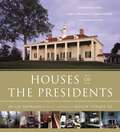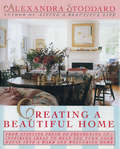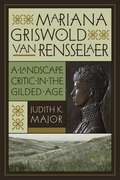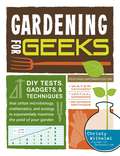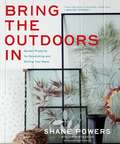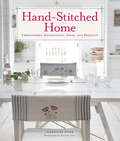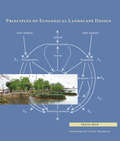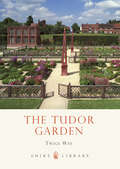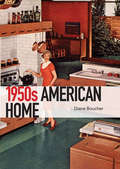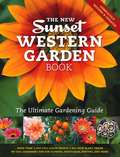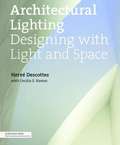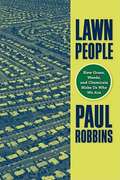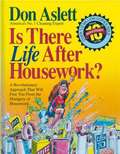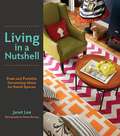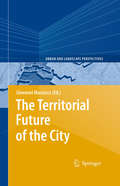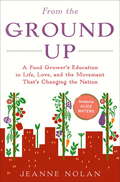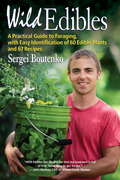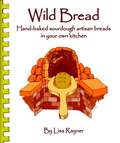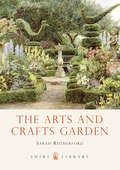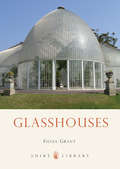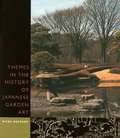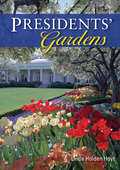- Table View
- List View
The Road to Le Tholonet: A French Garden Journey
by Monty DonThis is not a book about French Gardens. It is the story of a man travelling round France visiting a few selected French gardens on the way.Owners, intrigues, affairs, marriages, feuds, thwarted ambitions and desires, the largely unnamed ordinary gardeners, wars, plots and natural disasters run through every garden older than a generation or two and fill every corner of the grander historical ones. Families marry. Gardeners are poached. Political allegiances forged and shattered. The human trail crosses from garden to garden. They sit in their surrounding landscape, not as isolated islands but attached umbilically to it, sharing the geology, the weather, food, climate, local folklore, accent and cultural identity. Wines must be drunk and food tasted. Recipes found and compared. The perfect tarte-tartin pursued. None of these things can be ignored or separated from the shape and size of parterre, fountain, herbaceous border or pottager. So this is a book filled with stories and information, some of it about French gardens and gardening, but most of it about what makes France unlike anywhere else.From historical gardens like Versailles,Vaux le Vicomte and Courances to the kitchen gardens of the Michelin chef Alain Passard. There will be grand potagers like Villandry and La Prieure D'Orsan and allotments and back gardens spotted on the way. Monty also celebrates the obvious French associations of food and wine and finds gardens dedicated to vegetables, herbs and fruit.It is a book that any visitor to France, whether gardeners or not, will want to read both as a guide and an inspiration. It is a portal to get under the French cultural skin and to understand the country, in all its huge variety and disparity, a little better.
The Mosaics of Roman Crete
by Rebecca J. SweetmanThis book examines the rich corpus of mosaics created in Crete during the Roman and Late Antique eras. It provides essential information on the style, iconography, and chronology of the material, as well as discussion of the craftspeople who created them and the technologies they used. The contextualized mosaic evidence also reveals a new understanding of Roman and Late Antique Crete. It helps shed light on the processes by which Crete became part of the Roman Empire, its subsequent Christianization, and the pivotal role the island played in the Mediterranean network of societies during these periods. This book provides an original approach to the study of mosaics and an innovative method of presenting a diachronic view of provincial Cretan society.
Houses of the Presidents: Childhood Homes, Family Dwellings, Private Escapes, and Grand Estates
by Hugh Howard Roger StrausHOUSES OF THE PRESIDENTS offers a unique tour of the houses and day-to-day lives of America's presidents, from George Washington's time to the present. Author Hugh Howard weaves together personal, presidential, and architectural histories to shed light on the way our chief executives lived. Original photography by Roger Straus III brings the houses and furnishings beautifully to life. From Jefferson's Monticello to Reagan's Rancho del Cielo, with fascinating and surprising stops between and beyond, HOUSES OF THE PRESIDENTS presents a fascinating alternative history of the American presidency.
Creating A Beautiful Home
by Alexandra StoddardAlexandra Stoddard has brought beauty and grace to the lives of millions all over the world through her many books, including the phenomenal betseller, Living a Beautiful Life. In Creating a Beautiful Home, Alexandra Stoddard generously shares her professional secrets as an interior designer as well as her personal experiences in renovating and decorating her own 1775 home in Connecticut. Once again, her original and imaginative ideas for every room in the house will inform and inspire you on your own exciting journey of discovery as you transform your living space into a warm and welcoming oasis of harmony, beauty, and joy.
Mariana Griswold Van Rensselaer
by Judith K. MajorMariana Griswold Van Rensselaer (1851-1934) was one of the premier figures in landscape writing and design at the turn of the twentieth century, a moment when the amateur pursuit of gardening and the increasingly professionalized landscape design field were beginning to diverge. This intellectual biography--the first in-depth study of the versatile critic and author--reveals Van Rensselaer's vital role in this moment in the history of landscape architecture. Van Rensselaer was one of the new breed of American art and architecture critics, closely examining the nature of her profession and bringing a disciplined scholarship to the craft. She considered herself a professional, leading the effort among women in the Gilded Age to claim the titles of artist, architect, critic, historian, and journalist. Thanks to the resources of her wealthy mercantile family, she had been given a sophisticated European education almost unheard of for a woman of her time. Her close relationship with Frederick Law Olmsted influenced her ideas on landscape gardening, and her interest in botany and geology shaped the ideas upon which her philosophy and art criticism were based. She also studied the works of Charles Darwin, Alexander von Humboldt, Henry David Thoreau, and many other nineteenth-century scientists and nature writers, which influenced her general belief in the relationship between science and the imagination.Her cosmopolitan education and elevated social status gave her, much like her contemporary Edith Wharton, access to the homes and gardens of the upper classes. This allowed her to mingle with authors, artists, and affluent patrons of the arts and enabled her to write with familiarity about architecture and landscape design. Identifying over 330 previously unattributed editorials and unsigned articles authored by Van Rensselaer in the influential journal Garden and Forest--for which she was the sole female editorial voice--Judith Major offers insight into her ideas about the importance of botanical nomenclature, the similarities between landscape gardening and idealist painting, design in nature, and many other significant topics. Major's critical examination of Van Rensselaer's life and writings--which also includes selections from her correspondence--details not only her influential role in the creation of landscape architecture as a discipline but also her contribution to a broader public understanding of the arts in America.
Gardening for Geeks
by Christy WilhelmiGeek out with Mother Nature! There is much more to gardening than what you've learned in school. With Gardening for Geeks, you'll examine your ecosystem and discover how you can create the right environment for your plants. From analyzing meteorological patterns in order to plan productive beds to experimenting with the carbon and nitrogen levels in your soil, this book will teach you all about the developments and chemical reactions that occur at each phase of growth and how you can alter your planting techniques to construct the most thriving, productive garden possible. Each chapter also utilizes a wide range of inexpensive tests, gadgets, and methods that you can use to help evaluate, monitor, and enhance your plot. Complete with troubleshooting solutions and useful charts and graphs, Gardening for Geeks has everything you need to establish a beautiful and sustainable vegetable patch--one microclimate at a time!
Bring the Outdoors In
by Jennifer Cegielski Shane PowersNothing enlivens a room like a touch of nature. Taking the terrarium trend to the next level, this stunning guide will inspire crafters, garden lovers, and décor fans to turn flowers, leaves, and branches into striking, organic décor. Acclaimed designer and stylist Shane Powers presents 20 simple yet arresting projects for bringing natural tranquility to any space. Suited for garden enthusiasts and black thumbs alike, the projects use a range of live and dried plant materials to create colorful dried floral garlands, eye-catching willow wreaths, intriguing water gardens, and timeless succulent landscapes. With step-by-step instructions, styling and container ideas, helpful resources, and gorgeous photography, Bring the Outdoors In offers countless ways to welcome the natural world into any space.
Hand-Stitched Home
by Caroline ZoobA Hand-Stitched Home is one in which lovely embroidered designs personalize and enliven the space. These designs can be tiny embroidered details, decorative trims, or large, colorful pictures. In this uniquely beautiful volume, five sections and twenty-four embroidery projects reveal how to turn your living space into an elegant, inviting Hand-Stitched Home. Making PicturesA needle and thread are perfect tools to paint pictures--like a countryside image to adorn bookends or a nautical scene to transform a scrap of fabric into artwork so lovely that it begs to be framed. On the EdgeSimple decorative details can add beauty in the most unexpected of places. A light green print of ivy can embellish the edge of a chair cover, a print of kitchen supplies can makes shelf edging easy on the eyes. At the TableThe kitchen is the heart of the home and the table is the heart of the kitchen. A vibrant pinwheel design makes a stunning tablecloth runner, names or initials on placemats will bring the whole family together at mealtime. The Soft StuffNothing lends itself as easily to embroidery as blankets and pillows. Textured violets on a pillow or bright, scattered flowers on a white quilt fill living rooms and bedrooms with comfort and cheer. At the WindowEmbroidery allows everyday objects to add grace to the home. A white thread design on a sheer curtain or an embroidered pelmet are delightful accessories to guide sunshine into the home.
Principles of Ecological Landscape Design
by Travis BeckToday, there is a growing demand for designed landscapes--from public parks to backyards--to be not only beautiful and functional, but also sustainable. With Principles of Ecological Landscape Design, Travis Beck gives professionals and students the first book to translate the science of ecology into design practice. This groundbreaking work explains key ecological concepts and their application to the design and management of sustainable landscapes. It covers topics from biogeography and plant selection to global change. Beck draws on real world cases where professionals have put ecological principles to use in the built landscape. For constructed landscapes to perform as we need them to, we must get their underlying ecology right. Principles of Ecological Landscape Design provides the tools to do just that.
A Very Young Gardener
by Jill KrementzText and photographs feature highlights of the gardening year as six-year-old Ashley grows flowers and vegetables in her garden, looks at native plants in the woods, and visits a botanical garden. Other books by Jill Krementz are available in this library.
The Tudor Garden
by Twigs WayContrived, colourful, and cultured, the garden of the Tudor period was a paradise on earth, given over to pleasurable pastimes. Artificiality was the fashion of the age, with clipped and twined plants vying for space between brightly painted woodwork, and patterned beds of coloured soils. Renaissance discoveries reared their head in royal gardens, as traditional gold and green heraldic figures mingled with fantastical sundials and glittering fountains. Walls kept out the wild world beyond, whilst mounts permitted glimpses to new parklands, and provided raised platforms for the banqueting houses of the wealthy. Ever-changing with newly introduced exotic plants and yet never changing with year round knot gardens, the Tudor garden was an exciting pageant which this book seeks to explore.TOC: Introduction / Planting Paradise / Knots, Allees and Arbours / Moats, Ponds and Water Gardens / Mounts, Terraces, Pavillions and Banqueting Houses / Royalty and Pageant / Courting the Garden Queen / Gardens to Visit / Index
The 1950s American Home
by Diane BoucherThis title explores what life was like in the 1950s American home. An age of optimism, it is about living the American Dream and how this was achieved, changes in the home, new convenience technology, new ways of living. From Ranch House to American Modernism to affordable homes in the suburbs, this was how to live the good life in an era of unprecedented prosperity and opportunity.From the Trade Paperback edition.
The New Sunset Western Garden Book: The Ultimate Gardening Guide (Ninth Edition)
by Kathleen Norris BrenzelThis book is an indispensable reference for beginning and expert gardeners alike. Completely redesigned and updated, this ninth edition includes a fresh new look, thousands of color photographs, fresh illustrations, and an easy-to-follow format.
Architectural Lighting
by Hervé Descottes Cecilia E. RamosArchitectural Lighting, the latest addition to the Architecture Briefs series, provides both a critical approach to and a conceptual framework for understanding the application of lighting in the built environment. The key considerations of lighting design are illuminated through accessible texts and instructional diagrams. Six built projects provide readers with concrete examples of the ways in which these principles are applied. Short essays by architect Steven Holl, artist Sylvain Dubuisson, and landscape architect James Corner explore the role of lighting in defining spatial compositions.
Lawn People: How Grasses, Weeds, and Chemicals Make Us Who We Are
by Paul RobbinsFor some people, their lawn is a source of pride, and for others, caring for their lawn is a chore. Yet for an increasing number of people, turf care is a cause of ecological anxiety. In Lawn People, author Paul Robbins, asks, "How did the needs of the grass come to be my own?" In his goal to get a clearer picture of why people and grasses do what they do, Robbins interviews homeowners about their lawns, and uses national surveys, analysis from aerial photographs, and economic data to determine what people really feel about-and how they treat-their lawns. Lawn People places the lawn in its ecological, economic, and social context. Robbins considers the attention we pay our turfgrass-the chemicals we use to grow lawns, the hazards of turf care to our urban ecology, and its potential impact on water quality and household health. He also shows how the ecology of cities creates certain kinds of citizens, deftly contrasting man's control of the lawn with the lawn's control of man. Lawn People provides an intriguing examination of nature's influence on landscape management and on the ecosystem.
Is There Life after Housework? (10th Anniversary Edition)
by Don AslettDon Aslett has won the hearts of millions by showing them how to save up to 75% of the time they spend on housework with the help of his cleaning classic, Is There Life After Housework? Here you will find a revolutionary approach that frees you from the drudgery of housework by bringing the efficient methods and materials of the professional cleaner into the home, plus step-by-step instructions on how to clean every area of your home. How to find the life? Professional secrets to clean faster and better? How to speed-clean the house for company? The right way to do every household chore? Where to get professional tools and supplies ? How to choose and use chemicals that will do the work for you? How to get others to help? Quick checklists and charts for at-a-glance reference .
Living in a Nutshell
by Janet LeeA fireplace on wheels? A chandelier light by Xerox? A shrink-wrapped designer closet? These are just a few of the more than one hundred innovative projects in Living in a Nutshell, a DIY guide of decorating ideas that fool the eye into seeing and believing a little lair is larger and more glamorous than its four walls. Here are fresh ideas for enhancing every living area of a tiny space. All are simple, affordable, portable, and big on style. An illustrated survival tool kit as well as extensive listings of untapped, off-the-beaten-track design resources and a select buying guide round out this invaluable book.
The Territorial Future of the City
by Giovanni MacioccoThe volume brings together contributions by leading scholars and young academics with experience in the urban potential of the territory in situations not necessarily linked to the dense metropolis, its compact form or to city sprawl. What brings these scholars together is their common reflection on this central theme, though from varied disciplinary and experimental backgrounds. They offer new forms of representing social and spatial processes of the contemporary society.
From the Ground Up
by Jeanne Nolan Alice WatersAn inspiring story for everyone who's ever dreamed of growing the food they eat When Jeanne Nolan, a teenager in search of a less materialistic, more authentic existence, left Chicago in 1987 to join a communal farm, she had no idea that her decades-long journey would lead her to the heart of a movement that is currently changing our nation's relationship to food. Now a leader in the sustainable food movement, Nolan shares her story in From the Ground Up, helping us understand the benefits of organic gardening--for the environment, our health, our wallets, our families, and our communities. The great news, as Nolan shows us, is that it has never been easier to grow the vegetables we eat, whether on our rooftops, in our backyards, in our school yards, or on our fire escapes. From the Ground Up chronicles Nolan's journey as she returned seventeen years later, disillusioned with communal life, to her parents' suburban home on the North Shore as a single mother with few marketable skills. Her mother suggested she plant a vegetable garden in their yard, and it grew so abundantly that she established a small business planting organic gardens in suburban yards. She was then asked to create an organic farm for children at Chicago's Lincoln Park Zoo, and she soon began installing gardens around the city--on a restaurant's rooftop, in school yards, and for nonprofit organizations. Not only did she realize that practically anyone anywhere could grow vegetables on a small scale but she learned a greater lesson as well: rather than turn her back on mainstream society, she could make a difference in the world. The answer she was searching for was no further than her own backyard. In this moving and inspiring account, which combines her fascinating personal journey with the knowledge she gained along the way, Nolan helps us understand the importance of planting and eating organically--both for our health and for the environment--and provides practical tips for growing our food. With the message that we can create utopias in our very own backyards and rooftops, From the Ground Up can inspire each of us to reassess our relationship to the food we eat.Praise for From the Ground Up "The joy of From the Ground Up is not Nolan's own happy ending but rather the illuminating way she applies her vision to practical problems. . . . The hardest memoir to write is the one that is honest but not self-obsessed; Nolan accomplishes this with clarity and poise."--Jane Smiley, Harper's"By bravely sharing her personal journey in this remarkable book, Jeanne Nolan gives each of us a gift--one that has the power to motivate us to pursue the values we believe in, to free ourselves from convention, to be better parents, and to accept the love of family and community--however we define those. From the Ground Up resonates powerfully with me, as a gardener, and inspires me to 'double dig' my garden bed. But even readers who keep their fingernails clean will benefit from this beautiful story and powerful message."--Sophia Siskel, president and CEO of the Chicago Botanic Garden"I didn't expect that a book about the food movement would turn out to be a can't-put-it-down page-turner, but that's just what From the Ground Up is. Jeanne Nolan's personal journey is a richly observed saga set against the broad landscape of social and ecological change, and spurred by a reawakened awareness about the food that must sustain us."--Bill Kurtis, television journalist and founder of Tallgrass Beef
Wild Edibles
by Sergei BoutenkoIn this field guide to foraging wild edible plants, Sergei Boutenko (son of raw-food guru Victoria Boutenko) explores the health benefits of wild-harvested food, explains how to safely identify trailside weeds, herbs, fruits, and greens that grow worldwide, and shares his delicious, nutrient-dense recipes.Sergei Boutenko has been gathering wild plants since he was 13, when, early on in a 6-month hike from Mexico to Canada, he and his raw-food family ran out of provisions and turned to foraging for survival in the wild. Back in civilization, Boutenko was dismayed by the inferior quality of store-bought food and industrial agriculture, and began to regularly collect wild plants near his home and on his travels. Now, in Wild Edibles, he shares knowledge gleaned from years of live-food wildcrafting and thriving in harmony with nature.This practical guide to plant foraging gives hikers, backpackers, raw foodists, gardeners, chefs, foodies, DIYers, survivalists, and off-the-grid enthusiasts the tools to identify, harvest, and prepare wild edible plants. The book outlines basic rules for safe wild-food foraging and discusses poisonous plants, plant identification protocol, gathering etiquette, and conservation.Boutenko explores in detail the many rewards of eating wild flora: environmental protection, sustainability, saving money, economic self-sufficiency, and healthy living. He draws on thoroughly researched nutrition science to make a compelling case for the health benefits of a diverse, local-food diet that includes wild greens.The majority of the 60 edible plants described in this field guide can be found worldwide, including common-growing trees. Over 300 color photos make plant identification easy and safe. A chapter containing 67 high-nutrient vegan recipes--including green smoothies, salads and salad dressings, spreads and crackers, main courses, juices, and sweets--provides inspiration to join Sergei on the trail to radiant health."Wild Edibles: A Practical Guide to Foraging, with Easy Identification of 60 Edible Plants and 67 Recipes has taught me that my backyard is full of free food! Way to go, Sergei." --John Mackey, CEO of Whole Foods MarketFrom the Trade Paperback edition.
Wild Bread: Hand-Baked Sourdough Artisan Breads in Your Own Kitchen
by Lisa RaynerThis book explores what goes on inside dough as it is transformed from water, flour, wild yeast and probiotic bacteria into the kind of bread that makes your mouth water. You may never be satisfied with ordinary bread again. Once you learn what factors affect aroma, flavor, shape, crust and crumb, you too will be transformed into an artisan. Wild Bread encourages your creativity and provides the basic principles you need to bake any bread you desire without needing a recipe. Wild Bread teaches you how to make authentic whole grain sourdough artisan breads that are easy to knead by hand and make in the variable temperatures and humidities of an ordinary kitchen.
The Arts and Crafts Garden
by Sarah RutherfordThe Arts and Crafts Movement flourished in the late nineteenth and early twentieth centuries, espousing a return to simplicity, craftsmanship and beauty from the artifice and intensity of Victorian industry. While perhaps most famous for its architecture and furniture, garden design was fully encompassed within the Movement and Gertrude Jekyll, Edwin Lutyens, Inigo Triggs and Samuel Elgood were very influential figures. This exploration of the principles of the Arts and Crafts garden explains the inspiration applied from Stuart garden and cottage garden design, the wild gardens with winding paths, the precisely clipped hedges, the formal terrances and the billowing border plantings of bulbs, herbs and climbers. From the most formally clipped topiary to the most informal-looking wild borders, everything was carefully designed, and most often accentuated by gazebos, gateways, sundials, topiary and ponds. This beautifully illustrated book throws open the gates to the Arts and Crafts Garden and gives an extensive list of the best examples of these gardens in the UK.
Glasshouses
by Fiona GrantThe orangeries and glasshouses that stand in the gardens of many stately homes help to tell a three-century story of garden fashion. They reflect both the architectural and social trends of their time, but above all show an increasing ability to tailor the buildings to the needs of the plants within. Starting with the Restoration fashion for cultivating pineapples, oranges and bananas within palatial orangeries, Fiona Grant then explains the development of glasshouses through the eighteenth century into the heyday of diversification and specialisation that charaterized the Victorian period, to the eventual decline of great glasshouses after the First World War. The role of the glasshouse as a display of status and of an interest in botany, technology and architecture is explored, and the book is colorfully illustrated throughout.
Leper Priest of Moloka'i: The Father Damien Story
by Richard StewartIn May 1873, Father Damien De Veuster voluntarily became the first resident clergyman and part-time physician for the leper colony on Moloka'i's remote Kalaupapa peninsula. This volume traces the life of Father Damien from his boyhood in rural Belgium to his death at Kalaupapa after sixteen years of remarkable accomplishments. It analyzes much new information about Damien and his years in Hawai'i, giving a fuller understanding of the extent of Damien's work at the settlement and the tensions underlying his relations with Church bureaucrats. It is the story of one humble man with faith in God and in himself, who faced gargantuan challenges and triumphed.
Presidents' Gardens
by Linda Holden HoytThe White House is the most famous house in the world - yet its 18 acres of perfectly manicured grounds and magnificent gardens, much beloved by the Presidents and their families, are rarely seen by the public. This book is a horticultural celebration of these gardens, beginning with the influence of George Washington's beloved Mount Vernon on the design of the nation's capital and looking at the development of White House gardens over two centuries. Rare photographs perfectly illustrate highlights from the best of the presidential gardens, including Jackie Kennedy's Rose Garden, the Roosevelt wartime White House greenhouses and Michelle Obama's sustainability-inspired vegetable garden, which now produces food that is served to the First Family. The text is peppered with lively comments and useful tips from gardeners who contributed to White House beautification projects, serving many different Administrations.
